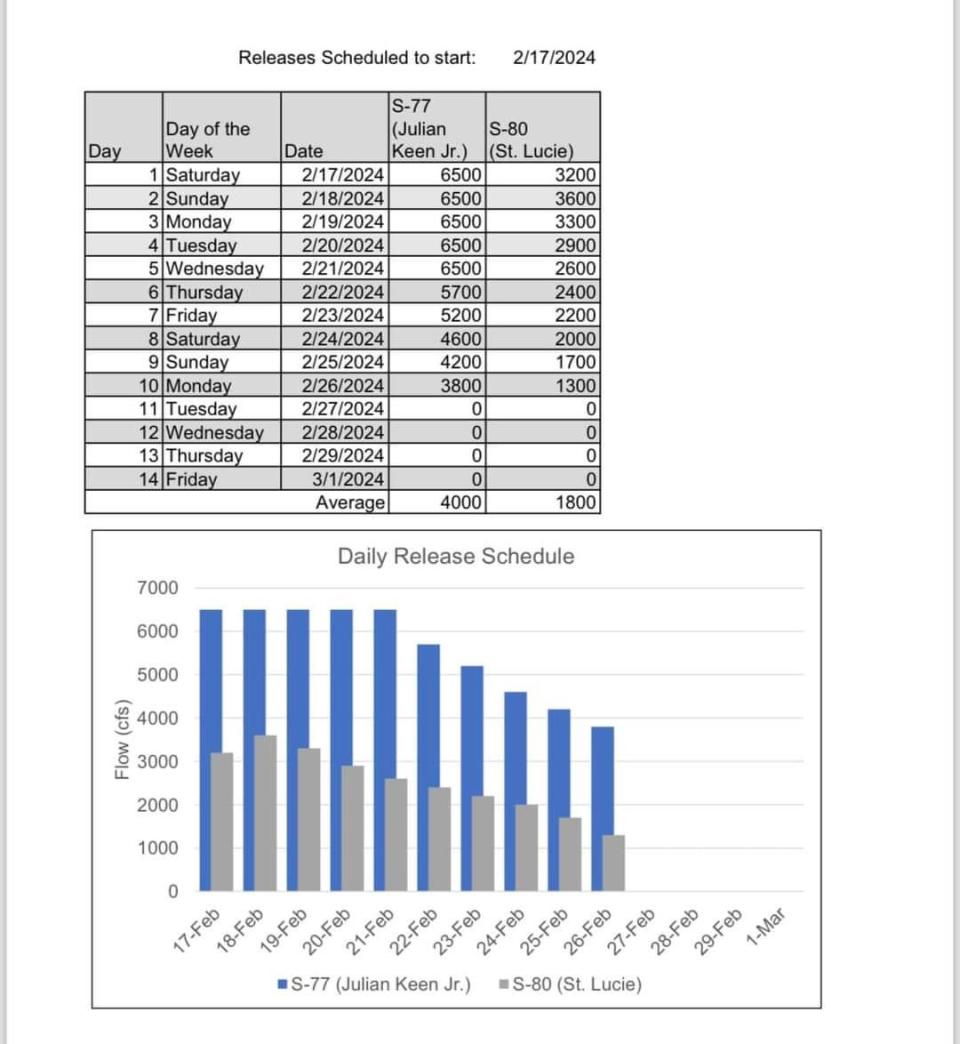Army Corps: Why the new Lake Okeechobee management rules wouldn't have stopped discharges
Treasure Coast residents are eager for the federal government to approve new Lake Okeechobee management rules, but the new rules wouldn't have stopped recent discharges to the St. Lucie River.
The new rules say the Army Corps of Engineers can discharge 2.3 billion gallons a day when the lake level is 16.5 feet or higher in February or March, but it was only 16.33 when the agency opened the floodgates Feb. 17. However, the new rules also say discharges can start whenever the forecast calls for heavy rains that will raise the lake level to 16.5 feet "within several weeks."
Some clean-water advocates have blamed the current discharges on the Army Corps' repeated delays in approving the new rules, called the Lake Okeechobee System Operating Manual (LOSOM), but that's a moot point.
“If the Lake Okeechobee System Operating Manual (LOSOM) was in place right now, we'd be having the same hard discussions about high releases. We are approximately a quarter of a foot below the LOSOM zone where high releases would be required, but our near zone authorities that are in LOSOM would allow us to conduct similar releases with the same timing that we are announcing today,” Col. James Booth said in a Feb. 16 conference call with South Florida media.
The Army Corps has said it expects to replace the old rules from 2008, called the Lake Okeechobee Regulation Schedule (LORS08), with LOSOM much later this year.
The Army Corps was able to invoke the new rules to prevent discharges during an algae bloom last summer, but that was under different circumstances. Booth credited the January 2023 completion of a project to strengthen the Herbert Hoover Dike around Lake O for allowing that flexibility, keeping water levels in the lake higher than under LORS08.
Brian Mast: Use LOSOM not LORS

The agency has at least four more months worth of work to do after a review of LOSOM by officials at the national level. Booth said he didn't know when the agency will reach a "record of decision."
U.S. Rep. Brian Mast, R-Fort Pierce, has urged the Army Corps to approve new lake management rules since 2018.
"It would be unacceptable for any colonel on any battlespace in anytime to say, 'Listen, I've got a new map today, but I'm using a map from five years ago,' ” Mast said at a Feb. 22 Rivers Coalition meeting. "You have a new map for 2024 that includes a new risk profile, repaired Herbert Hoover dike ... and if that new map is not being taken into account in every bit of that risk profile, then it's not being done the right way."
LOSOM's completion has been delayed five times since it began five years ago.
Lake Okeechobee discharges: Why wasn't Army Corps transparent about the volume of water?
LOSOM delays: Army Corps began new Lake O management plan 5 years ago. What is taking so long?
LOSOM will curb discharges
Here’s how LOSOM is projected to curb Lake O discharges by 37%, according to Booth:
Zero discharges to the St. Lucie River "under normal conditions," meaning 95% of the time. Under LORS08, there were discharges about 37% of the time.
Up to 1.3 billion gallons per day annually discharged to the Caloosahatchee River, the equivalent of 2,000 Olympic swimming pools. Unlike the St. Lucie, the Caloosahatchee needs some freshwater to balance salinity from the Gulf of Mexico.
65 billion gallons annual average flowing south to the thirsty Everglades — triple that under LORS08 — enough to cover 200,000 acres in a foot of water.
Prioritizes dry season discharges when microcystin algae is low.
Lake Okeechobee discharges

With discharges set to end April 1, the Army Corps so far has released about 8.3 billion gallons of lake water last week to the St. Lucie River:
Saturday: about 1.3 billion gallons
Sunday: about 1.9 billion gallons
Monday: about 1.8 billion gallons
Tuesday: about 1.8 billion gallons
Wednesday: 1.5 billion gallons
The agency hasn’t answered TCPalm's questions about the projected daily flow rate until April 1.
Katie Delk is an environmental reporter for TCPalm. Contact her at katie.delk@tcpalm.com or 772-408-5301. Check for updates at @katie_delk.
This article originally appeared on Treasure Coast Newspapers: Army Corps: New Lake Okeechobee rules wouldn't have stopped discharges

